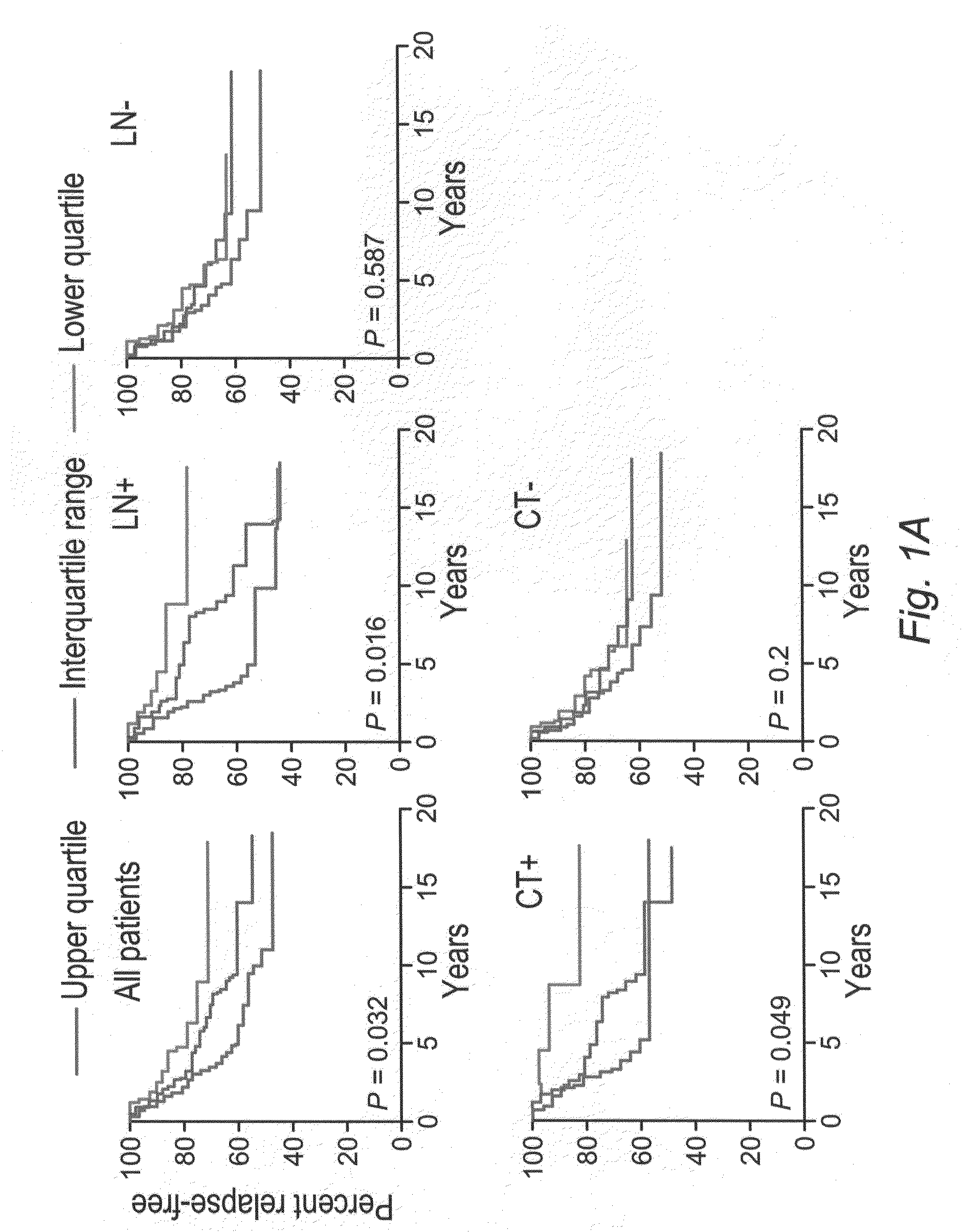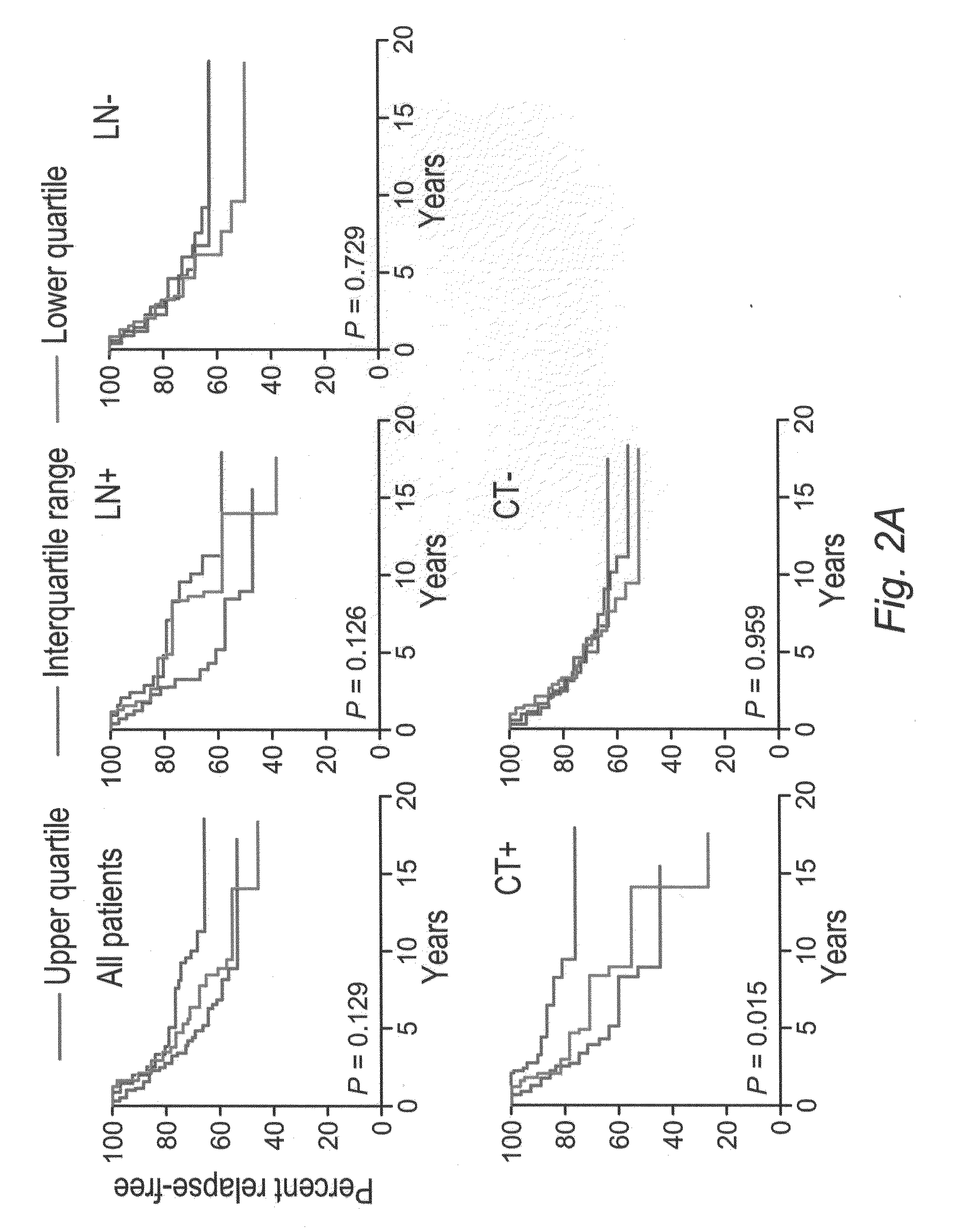Novel methods for predicting and treating tumors resistant to drug, immunotherapy, and radiation
a tumor and immunotherapy technology, applied in the field of tumor resistance prediction and treatment, can solve the problems of significant differences between drug resistance identified in experimental models, poor overall survival, and drug resistance acquired by tumor cells, and achieve the effect of increasing the sensitivity of a malignant tumor
- Summary
- Abstract
- Description
- Claims
- Application Information
AI Technical Summary
Benefits of technology
Problems solved by technology
Method used
Image
Examples
example 1
[0141]This example describes the identification of genetic markers associated with N-CoR2.
[0142]HMT3522 T4-2 malignant human breast epithelial cells, developed by Dr. O. W. Peterson (Cancer Res. 52:1210-1217, 1992), were used as a model. HMT3522 T4-2 cells were derived from an epidermal growth factor (EGF)-dependent breast epithelial HMT3522 S-1 cells and an EGF-independent HMT3522 S-2 cells that spontaneously became malignant when injected into nude mice. HMT3522 T4-2 cells were propagated as monolayers on type I collagen-coated plastic surface in chemically defined medium consisting of DMEM:F12 medium (Invitrogen GIBCO), containing 250 ng / ml insulin (Boehringer Mannheim), 10 μg / ml transferrin (Sigma, St. Louis, Mo.), 2.6 ng / ml sodium selenite (Collaborative Research), 10−10 M estradiol (Sigma), 1.4×10−6 M hydrocortisone (Collaborative Research), and 5 μg / ml prolactin (Sigma), as described in J. Cell Biol. 137:231-245 (1997).
[0143]HMT3522 T4-2 cells that stably overexpress N-CoR2 w...
example 2
[0149]This example demonstrates that N-CoR2 and HDAC3 expression is prognostic of the clinical outcome in breast cancer patients.
[0150]The transcriptional expression levels of N-CoR2, HDAC3, and associated clinical information, including therapeutic outcome and survival, were obtained from several publicly available tumor transcriptome data sets, including 295 patients with primary breast carcinomas (N. Engl. J. Med. 347:1999-2009 (2002)), 50 patients with malignant gliomas (Cancer Res. 63:1602-1607 (2003)), and 60 patients with ovarian carcinomas (J. Clin. Oncol. 22:4700-4710 (2004)). The patient survival data from the ovarian cancer data set was provided by D. Spentzos (Beth Israel Deaconess Medical Center and Harvard Medical School, Boston, Mass.). We searched the probe hybridization ratio (for two-color cDNA arrays) or the probe signal intensity (for Affymetrix arrays) of N-CoR2 (NCOR2) and HDAC3 (HDAC3) in each data set. If NCOR2 was represented by more than one probe set, the ...
example 3
[0159]This example demonstrates that genes whose expressions are associated with N-CoR2 are prognostic classifiers for the response to preoperative combinational chemotherapy in breast cancers.
[0160]To further show that the N-CoR2 signature genes are associated with increased resistance to systemic chemotherapy independent of other therapeutic interventions, the tumor transcriptome data set from a cohort of 133 breast cancer patients who received pre-operative (neoadjuvant) combination chemotherapy, including paclitaxel and fluorouracil-doxorubicin-cyclophosphamide, wherein the treatment responses were pathologically defined (J. Clin. Oncol. 24:4236-4244 (2006)), at the M.D. Anderson Cancer Center were analyzed. The patients who did not have residual cancer cells in the breast by pathological examinations following chemotherapy were considered as having clinically beneficial responses (i.e., “responders”) and those having residual cancer cells in the breast as “non-responders”. Thre...
PUM
| Property | Measurement | Unit |
|---|---|---|
| Volume | aaaaa | aaaaa |
| Size | aaaaa | aaaaa |
| Size | aaaaa | aaaaa |
Abstract
Description
Claims
Application Information
 Login to View More
Login to View More - R&D
- Intellectual Property
- Life Sciences
- Materials
- Tech Scout
- Unparalleled Data Quality
- Higher Quality Content
- 60% Fewer Hallucinations
Browse by: Latest US Patents, China's latest patents, Technical Efficacy Thesaurus, Application Domain, Technology Topic, Popular Technical Reports.
© 2025 PatSnap. All rights reserved.Legal|Privacy policy|Modern Slavery Act Transparency Statement|Sitemap|About US| Contact US: help@patsnap.com



